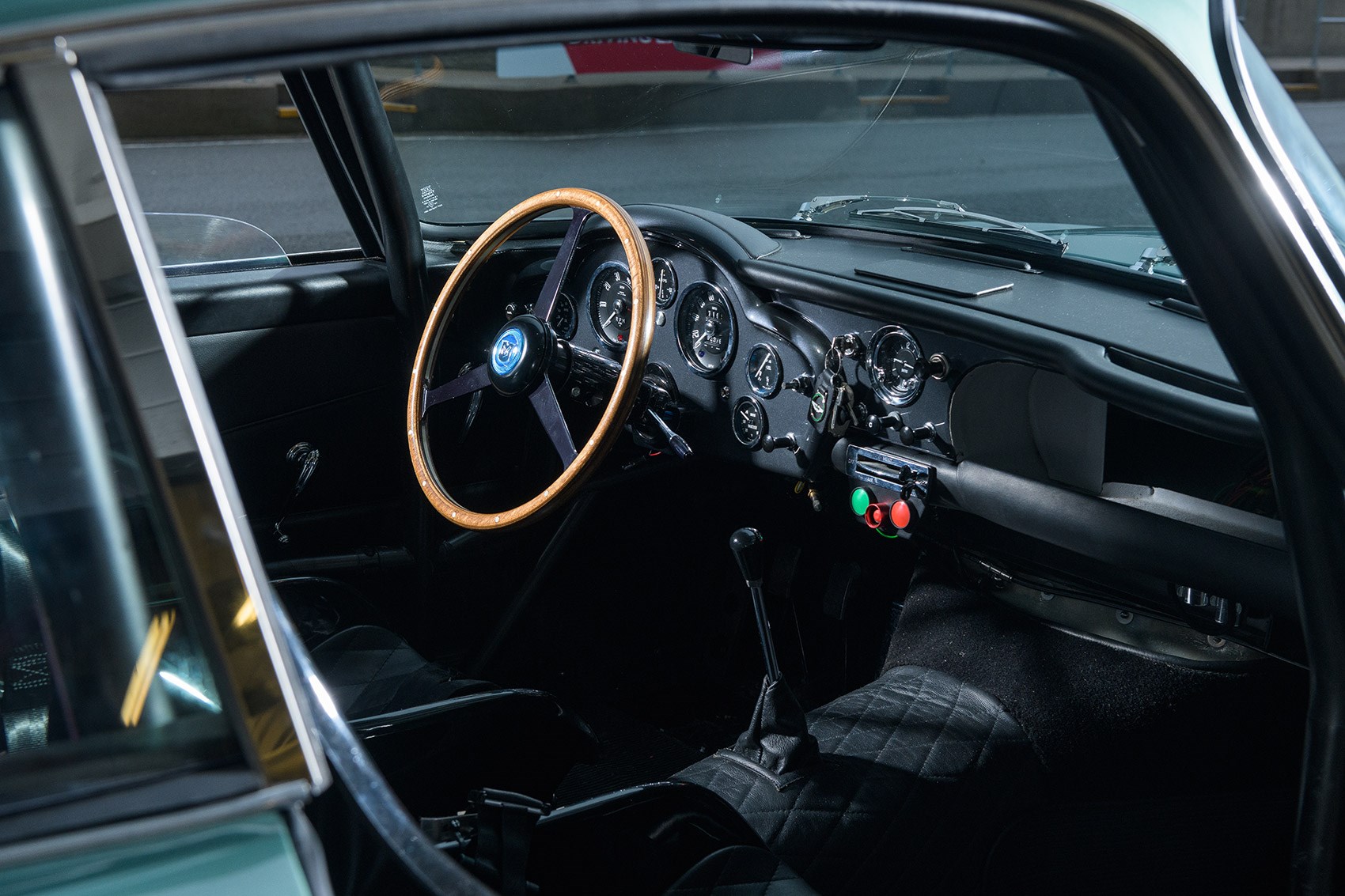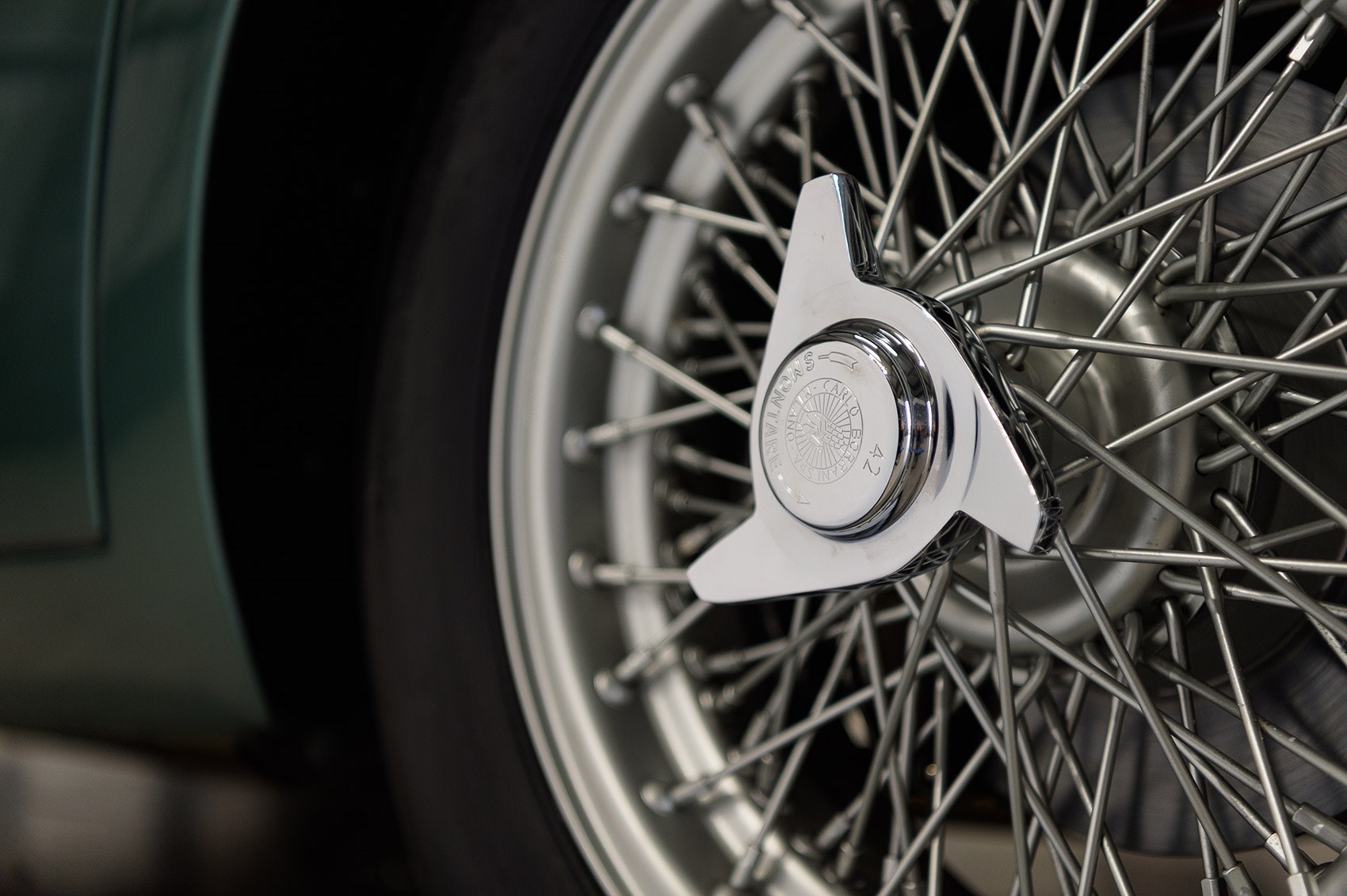► Aston Martin DB4 GT review
► We drive £1.5m Continuation
► Build starts on the new, old Aston
Aston Martin has confirmed build of the first DB4 GT Zagato Continuation is underway at its Heritage Division headquarters in Newport Pagnell. The first lucky customer will receive their car in ‘quarter three’ of 2019, so they’ll be counting down the days to the summer.
It takes a team of 30 people an estimated 4500 hours to build each DB4 GT Continuation (not accounting for time taken by suppliers), just 19 will be produced, and each costs £1.5m. Aston makes great play of the fact that this is David Brown era craftsmanship, boosted by modern engineering nous.
These figures all flit around my mind as the first new DB4 GT to be built in 55 years sits idling in the Silverstone pitlane, ready for me to drive – it’s winter, the track is damp and greasy, and hasn’t been used since before Christmas. It’ll be greener than the Aston’s immaculate fresh coat of paint. This is no time to test the Armco.
Rewind just one second… you’re driving a new DB4 GT? You mean restored, presumably?
No, we mean new. It’s Aston taking a leaf out of Jaguar’s book – they made six ‘continuation’ E-type Lightweights a few years ago, you might remember – but ramping up the economies of scale. Aston is building an all-new batch of 25 DB4 GTs at its Newport Pagnell facility, which last built cars in 2007 – a Vanquish S was the final car to come off the line – and has since been dedicated to maintaining and restoring older models.
Fittingly, it’s also where the originals were produced, from 1959 to 1963. Taking the regular DB4 as its starting point, the DB4 GT removed 13cm from the wheelbase, to reduce weight and increase agility for racing. The Tadek Marek 3.7-litre straight six engine was also fitted with a new twin-spark cylinder head, taking power from 266bhp to 302bhp.
It was still a relatively luxurious car, though, so buyers could also order Lightweight specification. Eight original cars were built to this spec, which included an aluminium floorpan and bulkheads, with holes drilled to save more weight. The bumpers, radio, glovebox lid and other fripperies were also all deleted.

The additions/deletions dropped weight from a regular GT’s 1269kg to 1128kg, according to period FIA homologation papers. Today, those cars swap hands for more than £3m. You’ve probably guessed that the continuation cars are built to Lightweight spec. The DB4 also evolved through its production, so Aston has taken the earliest models as inspiration. They’re distinguished by ‘cathedral’ rear lights, a high-set bonnet scoop, and very pretty they are too.
The DB4 GT proved successful from the off, with Stirling Moss winning on its debut at Silverstone in 1959, the very place we’re testing the new model. Later the DB4 GT was driven by greats including Innes and Roy Salvadori, entered Le Mans – though it only managed 1.5 hours – and raced with success until something called a Ferrari 250 GTO showed up.
Browse Aston Martins for sale
Surely Aston didn’t just dust off the original tooling and pick up where they left off?
It’s a tricky process. The team, led by Newport Pagnell MD Paul Spires and Programme Manager Simon Hatfield, began work in mid-2016, and digitally scanned ‘eight or nine’ original cars – they won’t tell us if that included Adrian Newey’s example – and studied 450 original drawings. ‘It was a very hard project, because the original car already exists,’ explains Hatfield. ‘You’re trying to replicate it perfectly, but you don’t have all the information required.’
‘We couldn’t have done this project 10 or 15 years ago,’ add Spires, ‘the technology just wasn’t there.’
As you’d expect of cars hand-built more than half-a-century ago, there was plenty of variation in the originals’ build, and Spires reports a left-hand kink in all the chassis they scanned, something they chose to iron out, which seems sensible to us.

The tubular mild-steel chassis is welded off-site, and the aluminium body panels pressed off-site too, but both are stitched together at Newport Pagnell. ‘The aluminium is 1.2mm thick, like the original spec, and my panel shop hated me for that!’ laughs Spires. ‘They wanted a thicker gauge, so it’d be easier to work by hand, but that was never going to happen – it would’ve been heavier, and not true to the original.’
Original suppliers have been used wherever possible, right down to Borani for the 16in wire wheels, and the company that supplied the door locks and still had the tooling. There’s even an agreement with coachbuilder Touring of Milan, who designed the bodywork. ‘They received a royalty on each of the original cars, so we put the same deal back in place, but index-linked to inflation,’ explains Spires.
Theses cars haven’t slavishly followed the original models’ spec, though. ‘Improving survivability for the driver in the event of a crash was essential for us,’ says Spires. So you’ve got modern FIA-approved rollcage, modern – but far from jarring – bucket seats and a ‘bagged’ fuel tank, to reduce the chance of fuel exploding should I exit backwards at Copse, which is reassuring.

But the continuation cars also perform better. The suspension is rose-jointed, meaning more precise-feeling metal-to-metal connections, not vaguer rubber-bushings. The engine grows to 4.2 litres, and now makes 340bhp. Modern brake pad material means it stops better too. Finally, for better durability, the gearbox is also a non-synchro, four-speed unit with straight-cut gears. All in, weight comes to 1260kg, more akin to the original DB4 GTs than Lightweight spec.
How do you get on around Silverstone?
Despite first and third gear being quite far apart, first and reverse feel separated by a flimsy partition wall, so I start my drive by slotting the slender little gear stick into reverse, leaning forwards in anticipation of my intended direction of travel but travelling backwards down the pitlane. The Aston team politely pretend not to notice, and things do thankfully improve. The clutch isn’t particularly tricky, and so long as you give the gear lever a very positive tug, the straight-cut gears engage very positively.
Downshifts are tricky, though, not so much the engagement, it’s more smoothing out the heel-and-toe technique – the brake pedal is pretty solid, but the throttle incredibly responsive, so I tend to over-blip it, perhaps fooled into thinking it’ll need more of a prod by those muscly brakes. The steering is far slower than modern cars, so what feels like a suitable input usually needs to be doubled to actually get into the bend – probably wise that Aston fitted the smaller wooden-rimmed steering wheel. But the steering actually feels intuitively weighted and very precise, no doubt thanks to the rose-jointed links.

My first lap is spent in over-cautious mode, but even then you can feel the Aston understeering and starting to float a little at the rear as the tyres begin to spin up – as you’d expect in these conditions, and on cross-ply rubber. But slowly I pick up the pace, and learn to just slot fourth gear early on and let the straight six’s brawny 350lb ft take the strain.
Do that and the engine bellows deeply from low revs, feeling tractable as it sucks fuel through triple Weber carbs, but despite the moderation, still the speed comes quickly and with a rousing higher-pitched roar as the rev needle dances – and it does dance, in period-accurate fashion – around the dial, the whine from the straight-cut gears adding to the mechanical drama, until I’m getting a bit carried away with the moment and travelling just a bit too quickly at the end of the Wellington Straight. Thankfully the brakes with their higher-friction material come to the rescue – the feel is good and solid, and the stopping power surprisingly strong, I think quite a lot better than the E-type Lightweight I drove, mostly with Clapton face under braking, so hard did I have to press the middle pedal.
When I press the Aston’s pedal hard, I’m sure I’ll lock up the front tyres on the greasy surface, but somehow I don’t, and the excess speed almost entirely wipes off. As I turn in for Brooklands just a little quicker than probably wise, the DB4 GT starts to push and understeer a fraction, the grainy warning signs filtering up through the steering rim, but as soon as I snap shut the throttle the nose tucks in and quickly I’m winding on opposite lock.
If it sounds a bit alarming, it actually gives me a massive confidence boost, because I know I can get the car stopped quickly, and that the adjustable chassis provides get-out-jail options beyond just piling headlong into the gravel trap with fistfuls of understeer.

It remains a relatively cautious outing, but the final time around the long right-hander at Luffield, I can’t resist seeing what a full-on slide feels like, so I turn in and feather the throttle, the engine snorting and honking loudly as that lovely big steering wheel slips through my fingers and the DB4 GT slews sideways. Hatfield meets me with a grin when I get back into the pits. ‘Imagine a gentleman driver, he’d be faster in a GT4 car, but what would give him more satisfaction to master?’ he asks rhetorically. I just nod and laugh.
How does the DB4 GT feel on the road?
It doesn’t, these cars aren’t road-legal. Some owners, inevitably, will find a way to get their cars approved for road use. But Aston does have another solution: a two-year international driving programme, that includes Yas Marina, Abu Dhabi. Owners can even receive instruction from Aston racing drivers, including GT3 ace Darren Turner. But I can’t think of any better way to experience the DB4 GT than following in Stirling Moss’s tyre tracks at Silverstone, almost 60 years since he first proved this car was a forced to be reckoned with.
Read more Aston Martin reviews here